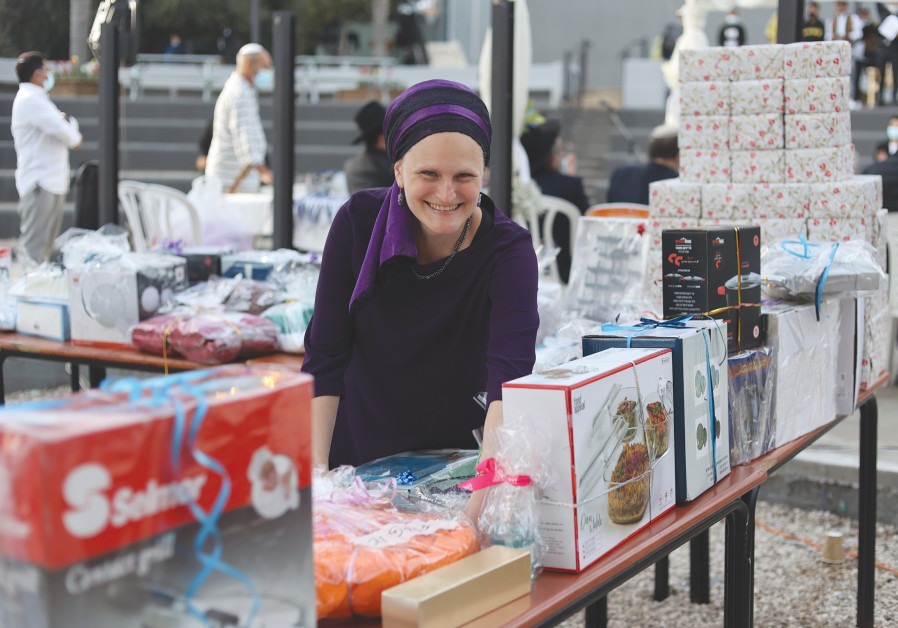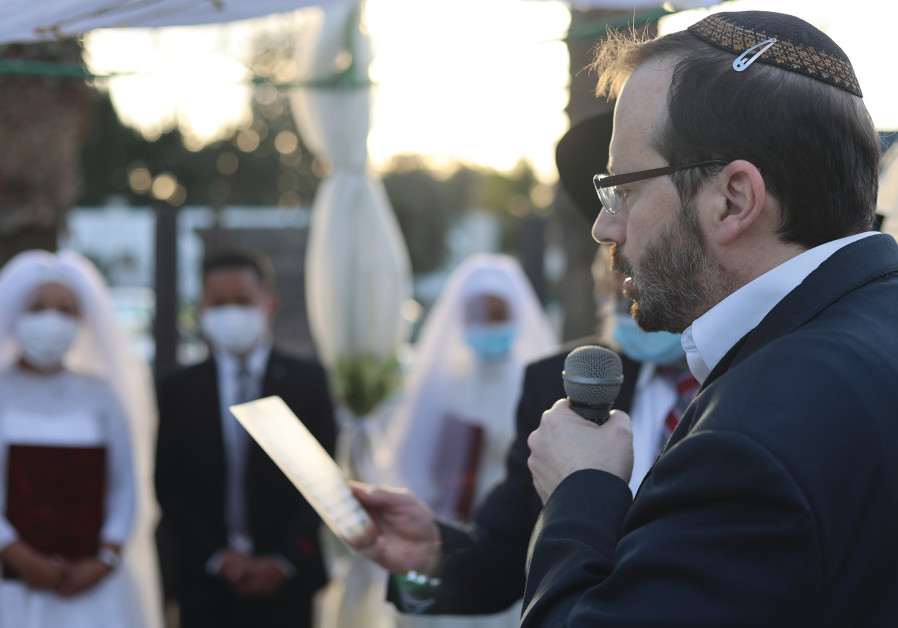Earlier this month, hundreds of brand new wedding gifts were donated, wrapped and delivered to a most unusual wedding ceremony held at Moshav Nordia near Netanya. The festive event was one of a series of weddings conducted on behalf of the Bnei Menashe, who are slowly returning to Israel after 2,700 years.
“Throughout their sojourn in exile, the Bnei Menashe continued to practice Judaism just as their ancestors did, including observing the Sabbath, keeping kosher, celebrating the festivals and following the laws of family purity. They continued to nourish the dream of one day returning to the land of their ancestors, the Land of Israel,” Shavei Israel’s chairman Michael Freund, a Jerusalem Post columnist, said. “Thus far, Shavei Israel has brought over 4,000 Bnei Menashe on aliyah from India and there are still another 6,500 awaiting their return to the Jewish homeland.”
According to Freund, after Shavei Israel brings the Bnei Menashe to Israel, they spend “three months living in the Shavei Israel Absorption Center at Nordia, where they complete the formal conversion process and then proceed to obtain Israeli citizenship and new immigrant status.”
Each time a group of Bnei Menashe completes their formal conversion, all married couples in the group need to get remarried according to Jewish law. The residents of Moshav Nordia assist Shavei Israel with arranging the group remarriage ceremonies.

Enter the Anglo olim
Shayna Levine-Hefetz made aliyah from Baltimore and lives in Gush Etzion. She is friends with Laura Ben-David, who serves as the director of Marketing and New Media for Shavei Israel.
Ben-David, a gifted photographer, attends all the remarriage ceremonies and posts pictures of the happy events on Facebook. After viewing some photos of a previous group ceremony, Levine-Hefetz contacted Ben-David and offered to help set up at the next wedding event. Ben-David explained to her that the residents of Moshav Nordia, where the Bnei Menashe immigrants have been living, take care of the set up.
Levine-Hefetz was not deterred. Learning that the Bnei Menashe immigrants leave almost all their possessions behind when they come to Israel, arriving with only one suitcase each, she had a brainstorm.
“They literally have to start over,” Levine-Hefetz said. “Maybe I can arrange for people to donate wedding gifts. I felt it would be more of a simcha with the rest of Amcha (the people of Israel) welcoming them to Israel. The amount of misirut nefesh (sacrifice and devotion) to come here and change their entire world and life is unbelievable.”
In a matter of days, she arranged a wedding gift drive in Gush Etzion and Efrat. She began by messaging a few friends to ask if they would serve as drop-off points all around Gush Etzion and Efrat.
Levine-Hefetz had lots of helpers. The Efrat collection points were coordinated by Diana Rosenfelder and included the Weglein, Farkas, Mark-Kapon and Newman families. Levine-Hefetz collected gifts from donors in Neve Daniel along with the Morowitz family in Elazar and the Spiezer family in Alon Shvut.
The project came together very quickly. The drive was announced just after Purim. In addition to the 150 or so gifts that were donated, some people donated cash. With those funds, Levine-Hefetz and her daughter were able to purchase multiple challa boards, sets of silverware, mugs and other household goods.
Levine-Hefetz was also able to secure a discount on 60 kiddush cups from the Emanuel Store in Jerusalem’s Talpiot neighborhood. The discount was authorized by the artist Yair Emanuel himself.
A week later, on a Sunday morning, another team of volunteers wrapped all the gifts in cellophane. “We inspected everything to make sure it was b’kavod (respectable). We matched smaller items with other related items and put together 120 gift packages plus a kiddush cup,” Levine-Hefetz reported.
Volunteer wrappers included Levine-Hefetz, Kiki Newman who, along with her husband, directs Chabad of Efrat for English speakers, Diana Rosenfelder, Eti Karasek Magen and Aviva Sherman. Levine-Hefetz gave a special shout out to, “Diana’s husband, Simon, [who] did a lot of shlepping the gifts from the different locations to the wrapping party and loading the cars.”

COMMENTING ON the success of the gift drive, Levine-Hefetz said, “People emptied their gift closets because they haven’t been to weddings all year. If we had had more than a few days’ notice, imagine what could be done! It was a really fun opportunity to bring together our communities.
“I feel like I [actually] did very little. The response was amazing. It was nice to feel like we’re welcoming them to Israel and also to the Jewish people. It was amazing to hear their stories.
“We are all olim – from Europe, Canada and the US. So really it was an olim helping olim project,” she commented.
Ben-David commented, “We really put our heart and soul into our work with the Bnei Menashe and it was so incredibly heartwarming and gratifying to see so many people in the community here in Israel do the same. Shayna really blew me away with her determination to help. I hope her excitement is contagious and we can do similar projects in other communities with future Bnei Menashe groups.”
Shavei Israel has been advocating for the Bnei Menashe for decades. They have emissaries in India working with the community and educators in a Jewish center facilitated by Shavei Israel. By the time the Bnei Menashe come to Israel, they are already rooted and practicing Jewish life. They are already deeply connected to Israel. Since there are already 4,000 Beni Menashe in Israel, most have families already here with whom they have been in touch.
Freund explained further, “In December 2020, we brought a group of more than 250 Bnei Menashe on aliyah. In mid-March, the group moved to Nof HaGalil, where Mayor Ronen Plott and the municipality have gone out of their way to embrace the Bnei Menashe and welcome them with open arms.
“The immigrants are entitled to study Hebrew in ulpan for 10 months, as well as undergo professional training if they so choose. Shavei Israel will continue to actively facilitate their absorption and integration into Israeli society.
“The political will to bring them [to Israel] exists, but there are many bureaucratic obstacles that need to be overcome. I am determined to do everything I can to ensure that every single Bnei Menashe in India who wishes to make aliyah will be able to do so. They are our long-lost brothers and sisters and they deserve to be here in the land of their ancestors, the Land of Israel.”
Commenting on the wedding gift drive, Freund said, “We are very grateful to Shayna Levine-Hefetz and the women of Gush Etzion for taking the initiative to organize a bridal shower for the Bnei Menashe couples who were remarried under the huppah, as well as for purchasing various gifts for the families.
“The Bnei Menashe immigrants greatly appreciated this moving gesture, which embodies the unity of the Jewish people as well as our sense of love and concern for one another.
“I hope that other communities in Israel and throughout the Jewish world will be inspired by the example set by Gush Etzion and step up to assist the Bnei Menashe as they return to our land and our people after 2,700 years of exile.”
In their work identifying and reuniting descendants of the Ten Lost Tribes with the rest of the people of Israel, Shavei Israel is currently active in more than a dozen countries. In addition to working with the Bnei Menashe from India, they provide assistance to the Bnei Anousim (descendants of the forced converts who are sometimes referred to by the derogatory term “Marranos”) in Spain, Portugal and South America, the Subbotnik Jews of Russia, the Jewish community of Kaifeng in China, descendants of Jews living in Poland and others.


